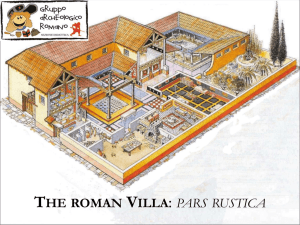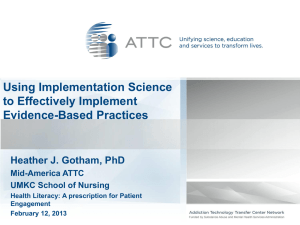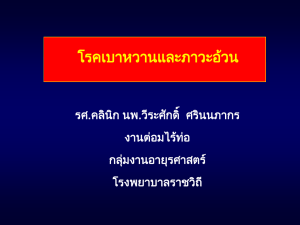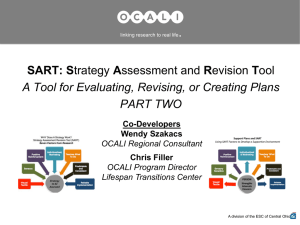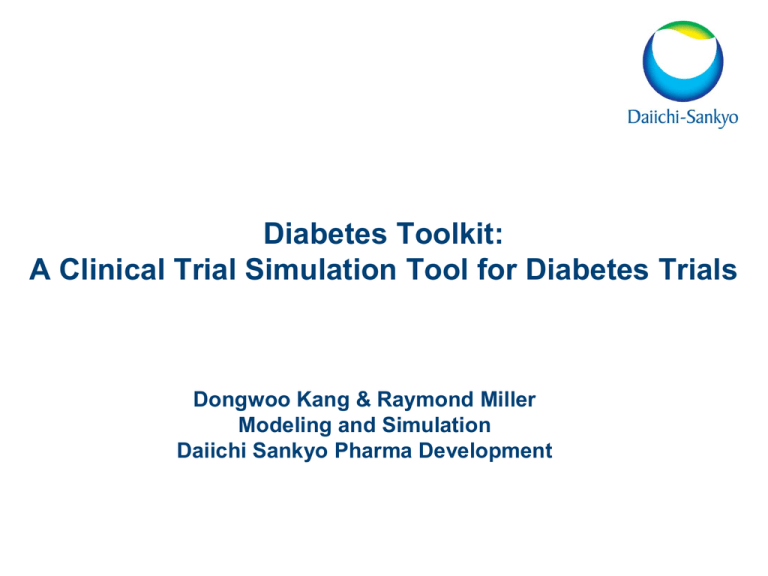
Diabetes Toolkit:
A Clinical Trial Simulation Tool for Diabetes Trials
Dongwoo Kang & Raymond Miller
Modeling and Simulation
Daiichi Sankyo Pharma Development
Introduction
• Requirements of clinical trial simulation
– Several procedures need to be done using various computing
tools
– Intermediate results have to be seamlessly passed down to the
next stage
• Diabetes Toolkit to do clinical trial simulation with ease
– Data generation, analysis, summary, and plotting are done in
one place using MSToolkit
– External NONMEM run can be called for advanced simulation
• Collaboration with Mango Solutions
– All-in-one R code package
page 2
MSToolkit
•
•
•
•
An R package for modeling and simulation
Developed by a few Pfizer colleagues, now freeware
Major component of Diabetes Toolkit
generateData(…)
• Calls other low level functions to generate simulated data
• Models can be specified by R function or NONMEM control
stream
• Stores data in ‘replicateData’ directory in the working directory
using filenames of ‘replicateNNNN.csv’
• analyzeData(…)
• Requires a valid R code or external file (*.R or *.SAS) for analysis
• Requires functions to perform micro-evaluation and macroevaluation summary
• analysisCode must return MEAN, SE, LOWER, UPPER, DOSE
page 3
Model for FPG and HbA1c
• Rivoglitazone model (Rohatagi et al., J Clin Pharmacol 2008)
was used to assess the feasibility of short term study of a new
page 4
compound
Flow diagram (Module 1):
Comparison with respect to baseline
Original dataset
Estimate model prm*
N Trial simulations to
obtain predicted
outcomes
Iteration
Compute probability of
success
*: NONMEM run is required. Currently this step is pre-run and output files are
provided within the toolkit.
page 5
Flow diagram (Module 2):
Comparison with respect to long term study
Original dataset
Subset 2 wk data
Subset 4 wk data
Estimate model prm
using 2 wk data*
Estimate model prm
using 4 wk data*
Trial simulation to obtain
prediction at 16 wk
Trial simulation to obtain
prediction at 16 wk
i≥N?
Yes
*: NONMEM run is called.
page 6
No
i≥N?
Yes
Compute similarity
index
Estimate model prm
using original data*
Trial simulation to obtain
prediction at 16 wk
No
Iteration
Chronological diagrams of Module 1 and 2
• Module I
Baseline
End of study
• Module II
Baseline
2wk
Baseline
2wk
Baseline
page 7
4wk
16wk
16wk
4wk
16wk
Definition of trial success
• Module 1: Comparison with respect to baseline
– Success if significant difference
– Mean FPG ≥ 10 mg/dL for all doses, or 3, 5 mg (ie, high doses)
– Mean HBA ≥ 0.3% for all doses, or 3, 5 mg
• Module 2: Comparison with respect to long term study
– Success if acceptable similarity
– |Mean FPG| < 5 mg/dL for all doses, or 0.5, 2, 5 mg (ie, key
doses for dose-response estimation)
– |Mean HBA| < 0.15% for all doses, or 0.5, 2, 5 mg
page 8
Module 1
require(diabetes)
# Whether to write the outputs to files
dowrite <- TRUE
# Set working directory
# options(diabetes.wkdir = getwd())
wkdir <- .verifyFolder(file.path(getOption("diabetes.wkdir"), "Module1"))
ctsdir <- .verifyFolder(wkdir, "cts")
resultdir <- .verifyFolder(wkdir, "output")
# set criteria values:
# endpoint - baseline <= criteria.CFB
# abs(prediction - original) <= criteria.PRED
options(criteria.CFB = c(FPG = -10, HBA = -0.3))
options(criteria.PRED = c(FPG = 5, HBA = 0.15))
# Get parameters from NONMEM outputs
pars <- paras.run2(file.path(system.file(package = "diabetes"), "unitTests", "testdata", "nmtran", "run2"))
# simulate data
simulateData( modelEqn = model.run2,
replicateN = 2, subjects = 50, treatSubj = c(10, 10, 10, 10, 10),
treatDoses = c(500, 1000, 2000, 3000, 5000), treatPeriod = c(0:112) * 24,
genParNames = names(pars$thetaMean), genParMean = pars$thetaMean, genParVCov = pars$thetaVCov,
genParCrit = paste(names(pars$thetaMean), ">= 0"),
genParBtwNames = pars$omega2theta, genParBtwMean = 0, genParBtwVCov = pars$omega2Mean,
conCovNames = names(pars$conCovMean), conCovMean = pars$conCovMean, conCovVCov = pars$conCovVCov,
conCovCrit = paste(names(pars$conCovMean), "> 0"),
disCovNames = pars$disCovNames, disCovVals = pars$disCovVals, disCovProb = pars$disCovProb,
respVCov = 0, workingPath = ctsdir
)
page 9
Module 1
# Analysis data by using default functions. You can define 'analysisCode' and 'macroCode' functions here
analyzeData(analysisCode = .microCode.run2.module1 , macroCode = .macroCode.run2.module1 , workingPath = ctsdir)
file.copy(file.path(ctsdir, "microSummary.csv"), resultdir, overwrite = TRUE)
file.copy(file.path(ctsdir, "macroSummary.csv"), resultdir, overwrite = TRUE)
# Read data
allDf <- readReplicate(workingdir = ctsdir)
microDf <- readMicrodata(workingdir = ctsdir)
# Write plots to file
if(dowrite){
pdf(file = file.path(resultdir, "out.pdf"))
}
# Analysis
cfb.HBA <- tableCFBCont(outvar = 'HBA', allDf = allDf, needwrite = dowrite, needplot = TRUE, resultdir = resultdir)
cfb.FPG <- tableCFBCont(outvar = 'FPG', allDf = allDf, needwrite = dowrite, needplot= TRUE, resultdir = resultdir)
cfbtest.HBA <- tableCFBTest(outvar = 'HBA', allDf = allDf, needwrite = dowrite, resultdir = resultdir)
cfbtest.FPG <- tableCFBTest(outvar = 'FPG', allDf = allDf, needwrite = dowrite, resultdir = resultdir)
plotBias(outvar = 'HBA', allDf = allDf)
plotBias(outvar = 'FPG', allDf = allDf)
plotTime(outvar = 'HBA', allDf = allDf, byCol = "REP")
plotTime(outvar = 'FPG', allDf = allDf, byCol = "REP")
plotDoseResponse(outvar = 'HBA', microDf = microDf)
plotDoseResponse(outvar = 'FPG', microDf = microDf)
if(dowrite) dev.off()
page 10
Module 1 run results: probability of success
100
• Success if significant difference
• Mean FPG ≥ 10 mg/dL
• Mean HBA ≥ 0.3%
HBA
0.5, 1, 2, 3, 5
5
0
1, 2, 3, 5
8
0
2, 3, 5
30
0
3, 5
56
6
5
82
20
60
40
FPG
0
20
Dose
p(Success)
80
FPG
HBA
1
2
3
4
5
100
Number of doses
• Success if significant difference
• For 3mg and 5mg
HBA
2.5
0.075
76
50
5
0.15
78
26
10
0.3
56
6
20
0.6
16
0
60
40
FPG
20
HBA ≥
0
FPG ≥
p(Success)
80
FPG
HBA
5
10
dFPG
page 11
15
20
Module 2
require(diabetes)
doWrite <- TRUE
# Whether to write the outputs to files
doNONMEM <- FALSE # Whether to invoke NONMEM to estimate parameters
# Set working directory
# options(diabetes.wkdir = getwd())
studydir <- .verifyFolder(file.path(getOption("diabetes.wkdir"), "Module2"))
study1dir <- .verifyFolder(studydir, "study1")
study2dir <- .verifyFolder(studydir, "study2")
if(!file.exists(file.path(study1dir, "ReplicateData"))) dir.create(file.path(study1dir, "ReplicateData"))
if(!file.exists(file.path(study2dir, "ReplicateData"))) dir.create(file.path(study2dir, "ReplicateData"))
# set criteria values:
# endpoint - baseline <= criteria.CFB
# abs(prediction - original) <= criteria.PRED
options(criteria.CFB = c(FPG = -10, HBA = -0.3))
options(criteria.PRED = c(FPG = 5, HBA = 0.15))
page 12
Module 2
#####################################################################
## Step 1: Simulate FPG and HAB for a long term study (eg. 16 wk) ##
#####################################################################
# Get parameters from NONMEM outputs
pars <- paras.run2(file.path(system.file(package = "diabetes"), "unitTests", "testdata", "nmtran", "run2"))
# simulate data
simulateData( modelEqn = model.run2,
replicateN = 2, subjects = 50, treatSubj = c(10, 10, 10, 10, 10),
treatDoses = c(500, 1000, 2000, 3000, 5000), treatPeriod = c(0:112) * 24,
genParNames = names(pars$thetaMean), genParMean = pars$thetaMean, genParVCov = pars$thetaVCov,
genParCrit = paste(names(pars$thetaMean), ">= 0"),
genParBtwNames = pars$omega2theta, genParBtwMean = 0, genParBtwVCov = pars$omega2Mean,
conCovNames = names(pars$conCovMean), conCovMean = pars$conCovMean, conCovVCov = pars$conCovVCov,
conCovCrit = paste(names(pars$conCovMean), "> 0"),
disCovNames = pars$disCovNames, disCovVals = pars$disCovVals, disCovProb = pars$disCovProb,
respVCov = 0, workingPath = studydir
)
obsData <- readReplicate(workingdir = studydir)
page 13
Module 2
#####################################################################
## Step 2: 2 wks analysis (study1)
##
#####################################################################
# read and subset observed data (the simulated 16 wks data in step 1)
obsData1 <- obsData[obsData$TIME <= 2*7*24, ]
write.csv(obsData1, file.path(study1dir, "study1.obs.csv"), row.names = FALSE)
# Re-estimate the parameters (if doNONMEM = FALSE, use the default 2 wk parameters)
if (doNONMEM) {
pars1 <- list()
for (i in 1:length(unique(obsData1$REP))) {
study1NMdir <- .verifyFolder(study1dir, "NM", paste("rep", unique(obsData1$REP)[i], sep = ""))
# NONMEM data preparing -- copy control file of 'run2'
ctlfile <- file.path(system.file(package = "diabetes"), "unitTests", "testdata", "nmtran", "run2", "run2.ctl")
file.copy(ctlfile, study1NMdir)
# NONMEM data preparing -- generate data file by using the observed data
convNMData(obsData1[obsData1$REP == unique(obsData1$REP)[i], setdiff(names(obsData1), "REP")],
NMNameMap = c(X.ID = "SUBJ", SID = "0", THR = "TIME", STDY = "0", DATE = "0", TIME =
"TIME", AMT = "DOSE",
CMT = "CMT", EVID = "0", MDV = "0", DV = "RESP", HV =
"0", AGE = "0", RACE = "0", SEX = "SEX",
WT = "0", HT = "0", CRE = "0", CL = "CLI", V2 = "V2I", V3 =
"V3I", KA = "KAI", Q = "QI",
ALAG = "ALAGI", FPG = "FPG", HBA = "HBA", NONN =
"NONN", DGRP = "0", LNDV = "log(RESP)"),
RespName = c("FPG", "HBA"), RespCMT = c(4, 5), OrderName = c("X.ID", "THR", "CMT"),
filename = file.path(study1NMdir, "new.csv"))
# invoke NONMEM to run the model and estimate the parameters
runNONMEM(ctlFile = file.path(study1NMdir, "run2.ctl"), nmDir = getOption("nmfe"), cleanFile = TRUE)
pars1[[i]] <- paras.run2(study1NMdir)
}
page 14
Module 2
} else {
pars1 <- list()
pars1_0 <- paras.run2(nmpath = file.path(system.file(package = "diabetes"), "unitTests", "testdata", "nmtran", "run2_2wk"),
xmloutputfile = "run2_2wks.xml",
csvdatafile = "new2wks.csv"
)
for (i in 1:length(unique(obsData1$REP))) {
pars1[[i]] <- pars1_0
pars1[[i]]$etaDf <- unique(obsData1[obsData1$REP == unique(obsData1$REP)[i], c("SUBJ", "ETA1", "ETA2", "ETA3", "ETA4",
"ETA5")])
}
}
# Do prediction
obsData1 <- read.csv(file.path(study1dir, "study1.obs.csv"))
predictBySim(obsData1, obsData, nmTheta = lapply(pars1, FUN = function(X) X$thetaMean),
nmEta = lapply(pars1, FUN = function(X) X$etaDf), times = c(0:112) * 24 ,
filename = file.path(study1dir, "study1.pred.csv"))
# Analyze the predicted data
predData1 <- read.csv(file.path(study1dir, "study1.pred.csv"))
for(i in unique(predData1$REP))
write.csv(predData1[predData1$REP %in% i, ], file = sprintf("%s/ReplicateData/replicate%04d.csv", study1dir, i), row.names = FALSE)
analyzeData(analysisCode = .microCode.run2.module , macroCode = .macroCode.run2.module1 , workingPath = study1dir)
page 15
Module 2
### summarization
con2wks.FPG <- tablePredSummary(outvar = c("FPG"),
allDf = predData1, trialvar = "REP", cuttime = 2*7*24,
needwrite = doWrite, resultdir = study1dir)
con2wks.HBA <- tablePredSummary(outvar = c("HBA"),
allDf = predData1, trialvar = "REP", cuttime = 2*7*24,
needwrite = doWrite, resultdir = study1dir)
con2wks.FPG
con2wks.HBA
### plot
if(doWrite) pdf(file = file.path(study1dir, sprintf("cfp[%s].pdf", "2wks")))
plotBox(obsDf = predData1, outvar = "HBA", trialvar = "REP")
plotBox(obsDf = predData1, outvar = "FPG", trialvar = "REP")
if(doWrite) dev.off()
#####################################################################
## Step 3: 4 wks analysis (study2)
##
#####################################################################
page 16
Demonstration
page 17
Summary
• Brief overview of clinical trial simulation and MSToolkit
• Diabetes Toolkit modules are demonstrated
• Module 1: To compute probability of trial success by evaluating
the magnitude of drug effect on output variables (eg., FPG,
HbA1c) with respect to their baseline values
• Module 2: To assess if short term study can replace the required
long term study by computing the similarity index using the output
variables predicted from short term study data and the long term
study values
page 18
Acknowledgements
• Mango Solutions
• Andy Nicholls
• Jim Ditchburn
• Jian Li
page 19

